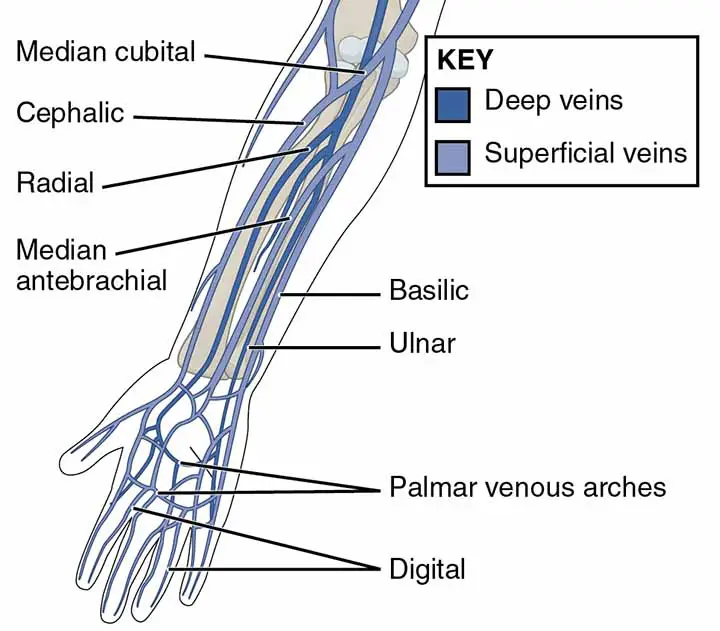Table of Contents
Median Cubital Vein Overview
The Median Cubital Vein is a broad communicating vein that transports blood from the cephalic vein to the basilic vein. It starts 2.5 cm below the bend of the elbow, runs obliquely upward and medially, and finishes 2.5 cm above the medial epicondyle in the basilic vein. The bicipital aponeurosis separates it from the brachial artery.
It may receive tributaries from the forearm’s front (median vein of the forearm) and connects to the deep veins through a perforator vein that pierces the bicipital aponeurosis.
Since the perforator vein connects to the median cubital vein, it is suitable for intravenous injections.
Clinical Points Summary
Since it is fixed by the perforator and does not slip away during piercing, the median cubital vein is the vein of choice(the best vein for IV) for intravenous injections, blood withdrawal from donors, and cardiac catheterization. In the absence of the median cubital vein, the basilic vein is favored over the cephalic because it is a more powerful tube. The basilic vein follows a straight line, while the cephalic vein bends sharply to flow into the axillary vein.

Beginning, Course, and Termination
The median cubital vein is a collateral branch of the cephalic vein, which runs on the anterolateral aspect of the upper limb. It runs superomedially through the cubital fossa, through the subcutaneous tissue, and empties into the basilic vein on the anteromedial side of the upper limb. The median cubital vein runs anterior to the bicipital aponeurosis, where the brachial artery and median nerve are located. The vein also runs anterior to the forearm’s medial and lateral cutaneous nerves. While there is some variation, the median cubital vein frequently receives the median antebrachial vein as the main tributary.
The median cubital vein often gives off a perforating branch, the deep median vein, along its path. This vein enters the cubital fossa through the fascial roof and anastomoses with a brachial vein, connecting the superficial and deep venous systems of the upper limb. Some parts of the upper limb have similar anastomotic relations. Because of its prominence and relative ease of access, the median cubital vein is a popular location for venipuncture.

Clinical Points
Safe Site for Injection and Venipuncture
Some research used ultrasonography to assess the depth and cross-sectional area of each superficial vein before and after tourniquet application, as well as the distance between each superficial vein and the median nerve or brachial artery, to determine healthy and appropriate venipuncture sites for nursing in the clinical setting.
Method and Procedure
Twenty fit volunteers were recruited for one of these trials. The apparent rate of each superficial vein before and after tourniquet application was 65% for the basilic vein, 90% to 95% for the median cubital vein, and 60% to 80% for the cephalic vein. After tourniquet application, the cross-sectional area of the median cubital vein was slightly greater than that of the basilic vein and cephalic vein. The distance between the basilic vein and the median nerve was slightly less than the distance between the cephalic vein and the median nerve. The distance between the basilic vein and the brachial artery was slightly less than the distance between the cephalic vein and the brachial artery.
Result and Interpretation
Because of its proximity to the median nerve and brachial artery, the cephalic vein at the cubital fossa is a relatively protected venipuncture site, according to these findings. When it is difficult to puncture the cephalic vein because it is not visible, the median cubital vein at the cubital fossa can be chosen for venipuncture due to its cross-sectional area and visibility; however, caution must be taken to avoid penetrating the vein because the median nerve and brachial artery are situated underneath.
Injection Site Reaction
Injection site reactions (ISRs) are a local phenomenon characterized as a cluster of symptoms that include swelling, erythema, pruritus, and pain near the injection site. This article examines the various aspects of ISRs, such as their epidemiology and pathogenesis, and offers practical advice about how to identify and treat such reactions. More emphasis is placed on FDA-approved biological agents and biosimilars, which are primarily used to treat dermatological conditions such as psoriasis, atopic dermatitis, and chronic urticaria. ISRs are significant complications of all FDA-approved self-injectable biological agents in both adults and infants, with research indicating a 0.5-40% incidence rate. According to the paper, ISRs are not linked to drug efficacy or the production of anti-drug antibodies. As a consequence, confusing the pathophysiology of ISRs, the majority of which are not allergic or immunogenic reactions, may result in unnecessary treatment discontinuation. Almost all local reactions to biological agents administered subcutaneously can be avoided by modifying injection procedures, patient education, and training.
Summery
The median cubital vein connects the basilic vein and the cephalic vein on the cubital fossa. It’s the most used venipuncture spot because of its prominence, visibility, and absence of slipping intention. Though injecting the substance in this vein may produce some adverse reactions.
There is some difference between this vein’s blood sample, ear lobe blood sample, and finger tip sample. Over the years several studies are going on to find out which sample is best and possesses the highest possible indication and diagnostic criteria.
The median cubital vein still stands out amongst them all.
We prefer this vein’s sample in most of the common cases.
Last Updated on February 23, 2022 by Learn From Doctor Team






